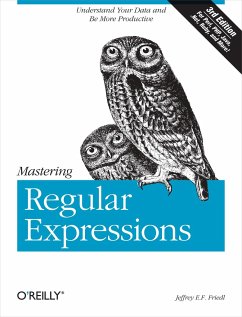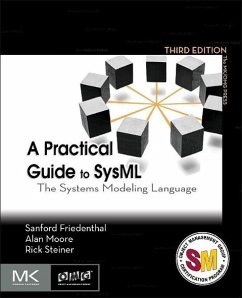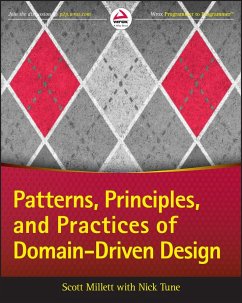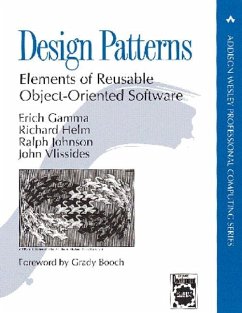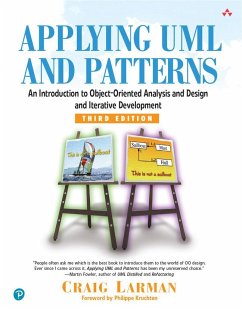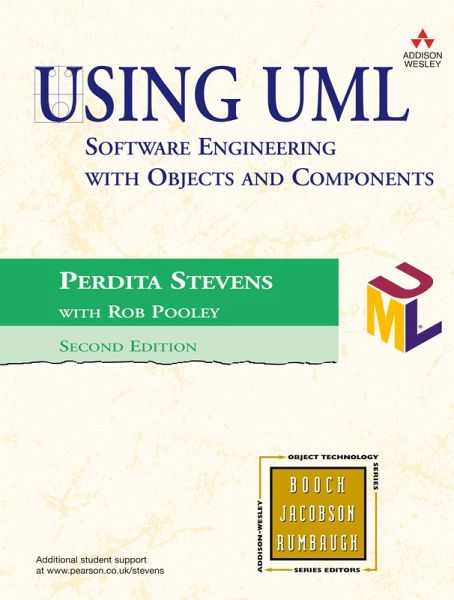
Using UML

PAYBACK Punkte
32 °P sammeln!
One of the first textbooks to be fully up-to-date with the new and expanded UML 2.0 standard, this is an ideal introduction to the Unified Modelling Language for students learning about object and component-based software design and development.
The book encourages a pragmatic and open-minded approach to real-life software engineering. It places UML in the context of the software engineering discipline as a whole, providing students with a practical understanding of best practice in software design and development.
The authors present a broad view of the subject area, enabling students to see for themselves how different practices may be appropriate for different situations.
The book is divided into four parts covering:
Part 1 - Introductory Concepts
Part 2 - UML, the language
Part 3 - Case studies
Part 4 - Applying UML in practice
Features + Benefits
Sidebars on important distinct issues.
Self-test questions to aid understanding.
Discussion questions to encourage deeper exploration and understanding.
UML features explained using case studies.
Technical notes on UML.
Rich accompanying website.
Boxed sections cover important issues such as Design by Contract, the Law of Demeter, and persistence.
Additional Support Material
Companion website with:
- Source code for cases
- Pointers for additional research
- Instructor's material
Backcover
Using UML
Software Engineering with Objects and Components
Second Edition
Perdita Stevens with Rob Pooley
Completely updated with the new and expanded UML 2.0 standard, this is the ideal introduction to the Unified Modelling Language.
Designed for students and practitioners learning about object- and component-based software design and development, the book encourages a pragmatic and open-minded approach to real-life software engineering. It places UML in the context of the software engineering discipline as a whole, providing readers with a practical understanding of best practice in software design and development.
Features of UML 2.0 discussed in this edition include:
The ball and socket notation for interfaces.
New notation for sequence diagrams.
UML 2s two different kinds of state machines, and when to use them.
Revised component structure and deployment diagrams.
Using UML also provides a wealth of learning aids, including:
Self-test questions to promote understanding.
Discussion questions to encourage deeper exploration.
Technical notes on specific UML features.
Boxed sections covering important issues such as Design by Contract, the Law of Demeter, and persistence.
Perdita Stevens is a Reader in the Schoolof Informatics at the University of Edinburgh. Her teaching and research interests lie mainly in tools and techniques for supporting software design and redesign. Rob Pooley is a Professor in the School of Mathematical and Computer Sciences at Heriot-Watt University in Edinburgh.
The companion website includes:
Source code for case studies
Pointers for additional research
Instructor's resource material
Part One: Conceptual background
Chapter 1 - Software engineering with components
Chapter 2 - Object concepts
Chapter 3 - Introductory case study
Chapter 4 - The development process
Part Two: The Unified Modelling Language
Chapter 5 - Essentials of class models
Chapter 6 - More on class models
Chapter 7 - Essentials of use case models
Chapter 8 - More on use case models
Chapter 9 - Essentials of interaction diagrams
Chapter 10 - More on interaction diagrams
Chapter 11 - Essentials of state and activity diagrams
Chapter 12 - More on state diagrams
Chapter 13 - Architectural and implementation diagrams
Chapter 14 - Packages and models
Part Three: Case studies
Chapter 15 - CS4 adminstration
Chapter 16 - Board games
Chapter 17 - Discrete event simulation
Part Four: Towards practice
Chapter 18 - Reuse: components, patterns
Chapter 19 - Product quality: verification, validation, testing
Chapter 20 - Process quality: management, teams, QA
Bibliography
The book encourages a pragmatic and open-minded approach to real-life software engineering. It places UML in the context of the software engineering discipline as a whole, providing students with a practical understanding of best practice in software design and development.
The authors present a broad view of the subject area, enabling students to see for themselves how different practices may be appropriate for different situations.
The book is divided into four parts covering:
Part 1 - Introductory Concepts
Part 2 - UML, the language
Part 3 - Case studies
Part 4 - Applying UML in practice
Features + Benefits
Sidebars on important distinct issues.
Self-test questions to aid understanding.
Discussion questions to encourage deeper exploration and understanding.
UML features explained using case studies.
Technical notes on UML.
Rich accompanying website.
Boxed sections cover important issues such as Design by Contract, the Law of Demeter, and persistence.
Additional Support Material
Companion website with:
- Source code for cases
- Pointers for additional research
- Instructor's material
Backcover
Using UML
Software Engineering with Objects and Components
Second Edition
Perdita Stevens with Rob Pooley
Completely updated with the new and expanded UML 2.0 standard, this is the ideal introduction to the Unified Modelling Language.
Designed for students and practitioners learning about object- and component-based software design and development, the book encourages a pragmatic and open-minded approach to real-life software engineering. It places UML in the context of the software engineering discipline as a whole, providing readers with a practical understanding of best practice in software design and development.
Features of UML 2.0 discussed in this edition include:
The ball and socket notation for interfaces.
New notation for sequence diagrams.
UML 2s two different kinds of state machines, and when to use them.
Revised component structure and deployment diagrams.
Using UML also provides a wealth of learning aids, including:
Self-test questions to promote understanding.
Discussion questions to encourage deeper exploration.
Technical notes on specific UML features.
Boxed sections covering important issues such as Design by Contract, the Law of Demeter, and persistence.
Perdita Stevens is a Reader in the Schoolof Informatics at the University of Edinburgh. Her teaching and research interests lie mainly in tools and techniques for supporting software design and redesign. Rob Pooley is a Professor in the School of Mathematical and Computer Sciences at Heriot-Watt University in Edinburgh.
The companion website includes:
Source code for case studies
Pointers for additional research
Instructor's resource material
Part One: Conceptual background
Chapter 1 - Software engineering with components
Chapter 2 - Object concepts
Chapter 3 - Introductory case study
Chapter 4 - The development process
Part Two: The Unified Modelling Language
Chapter 5 - Essentials of class models
Chapter 6 - More on class models
Chapter 7 - Essentials of use case models
Chapter 8 - More on use case models
Chapter 9 - Essentials of interaction diagrams
Chapter 10 - More on interaction diagrams
Chapter 11 - Essentials of state and activity diagrams
Chapter 12 - More on state diagrams
Chapter 13 - Architectural and implementation diagrams
Chapter 14 - Packages and models
Part Three: Case studies
Chapter 15 - CS4 adminstration
Chapter 16 - Board games
Chapter 17 - Discrete event simulation
Part Four: Towards practice
Chapter 18 - Reuse: components, patterns
Chapter 19 - Product quality: verification, validation, testing
Chapter 20 - Process quality: management, teams, QA
Bibliography
The essentials of UML 2.0 and how to use it in one concise volume.




